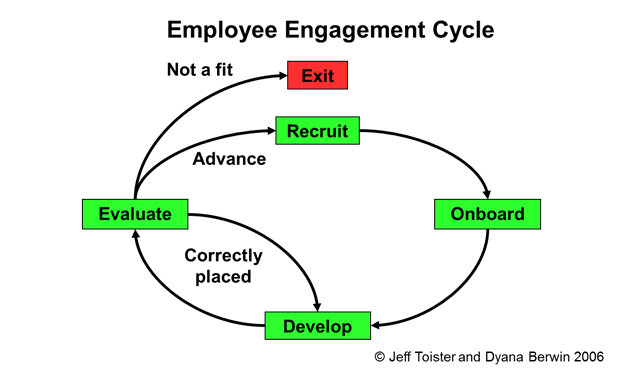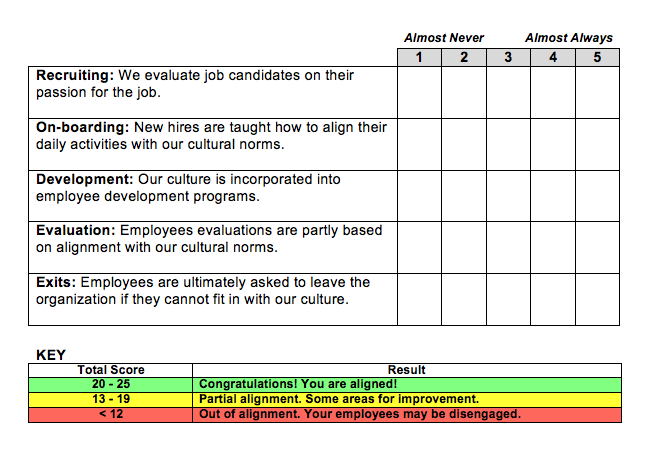Using the Employee Engagement Cycle
This post originally appeared on the International Customer Management Institute (ICMI) website as part of their Expert's Angle series.
Call centers with customer-focused cultures achieve their success by getting a high level of agent buy-in. One way to do this is to ensure that your culture is aligned with the five steps in the Employee Engagement Cycle. This is a framework that identifies critical points where a call center can influence employee engagement.
Read on to learn about each step in the cycle. At the end you’ll find a questionnaire you can use to evaluate your own call center’s alignment.

Recruiting
Recruiting new employees represents an opportunity to find people who are passionate about our products or services. Even more important than previous job experience or call center skills, we want people who will love to do what we want them to do. These employees will serve our customers better, work harder, and are less likely to leave the company than someone who is just here for a paycheck.
Call centers can hire for passion by identifying a set of specific traits that the ideal employee should possess. For example, a company that connects people with music teachers hires people who love music. A software manufacturer hires people who work with computers in their spare time. A company that sells accessories for boats and RVs hires people who love boating or camping.
On-boarding
The on-boarding process is more than just new employee orientation or that pile of new hire paperwork. On-boarding really refers to the period that begins when the employee accepts the job offer and ends when the employee is fully trained. This is a critical time when the employee decides whether they made a good decision to join your company. This is also when they learn about your call center culture and the behaviors that are expected to go along with it.
One medical device manufacturer used the on-boarding period to help their new employees unlearn habits they picked up in other call centers. For example, in their previous job a new employee may have referred to an out of stock product as being “on backorder” and simply quoted an expected time when the item would be back in stock. Here, an unavailable product wasn’t acceptable since a patient might need it for an upcoming surgical procedure. Finding the right product was the top priority, and employees were expected to go to great lengths to find a solution, even if it meant contacting another client to see if they had one that could be borrowed. Most new employees were never expected to do all that in their previous call center jobs, so the on-boarding period was an important step towards creating new habits.
Development
Companies that spend time hiring right and instilling cultural values in new employees can still lose their way if those values aren’t consistently reinforced. In many cases, the cultural norms taught during the on-boarding period don’t match the reality of the new employee’s day-to-day working environment. One way to avoid this problem is to ensure that all employee development includes a culture component as a way of consistently reminding employees about culture.
A software company successfully reinforced its culture throughout their call centers by insisting that all employee development programs be connected in some way to their company values. For example, when they instituted a customer service training program, a module was included that showed call center agents how to serve their customers in a way that was consistent with the organizational values. After the training, call center supervisors reinforced the values when providing an agent with feedback about their performance or coaching them on how to handle a particular call.
Evaluations
Annual performance evaluations don’t have a lot of fans these days. They are often treated as little more than a stack of annoying paperwork designed to give employees seemingly arbitrary ratings on a set of generic qualities such as “teamwork” or “dependability.” Annual performance reviews can become much more impactful when they are used to reinforce company culture
In one example, a company’s values were incorporated into performance evaluations and employees were evaluated in part on how aligned they were with the culture. The evaluation form contained a set of behavioral descriptions for each value to help differentiate between positive (or “aligned”) performance and negative (or “misaligned”) performance. This turned the evaluation into an opportunity to discuss culture, set goals for future performance, and align employee performance with desired norms.
Exits
We’ve all seen the impact of employees who actively work against the company’s best interests. These employees’ behavior becomes so toxic that it impacts other employees’ performance, and they may even attempt to recruit others to join them in their state of discontent. If left unchecked, toxic employees can lower morale, reduce call center performance, and cause increased turnover.
The best solution to dealing with toxic employees is to make it clear their behavior won’t be tolerated. Give them the choice of aligning their behavior with cultural expectations or leaving the team. Employees who refuse to be a positive part of your culture should be removed from the team as quickly as legally possible. It’s never an easy step to take, but I’ve observed countless managers who immediately saw improvements in morale and productivity after letting a toxic employee go.
Conclusion
Here’s a quick quiz if you’d like to evaluate your call center’s cultural alignment. It can be used to foster internal dialogue around better aligning the steps in the Employee Engagement Cycle.
